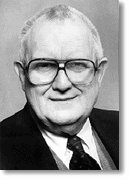
 A memorial service will be held at 1 p.m. on Dec. 6 in Baird Hall on the UB
North Campus for John R. Border, 70, an internationally known
researcher at
UB who died Nov. 11 of a heart attack at his South Wales home. His
pioneering work continues to save thousands of accident and injury victims
from multiple-system organ failure.
A memorial service will be held at 1 p.m. on Dec. 6 in Baird Hall on the UB
North Campus for John R. Border, 70, an internationally known
researcher at
UB who died Nov. 11 of a heart attack at his South Wales home. His
pioneering work continues to save thousands of accident and injury victims
from multiple-system organ failure. Border, who joined the UB faculty in 1965 as a member of the Department of Surgery, was director of the trauma service at Erie County Medical Center (ECMC) and director of the Trauma Research Program in the UB School of Medicine and Biomedical Sciences from 1968 until his retirement in 1991, when he became professor emeritus of surgery and orthopedics.
In the early 1970s, he led a team of UB researchers in developing treatment plans to prevent the stress of severe, multiple trauma from producing a chain of biochemical events that, if not treated with combination protein and glucose therapy, could lead to death.
Before the group's work was universally accepted, many who suffered severe injuries improved following surgery and other treatment, but suddenly took a downhill course and died.
In a 1982 interview, Border explained that when the body does not receive adequate amounts of protein to meet increased demands to maintain function and begin repair of damaged tissue, it draws on its own resources from muscle and other vital organs.
"The fatal sequence-multiple-system organ failure-must be recognized and treated as soon as possible after the original trauma," he emphasized.
Much of the lifesaving research over the years was funded at UB through grants from the National Institute of General Medical Services.
Although officially "retired," Border continued his work, both locally and internationally, to improve the treatment of trauma patients.
Wearing his trademark fire-engine-red suspenders, white shirt and tan slacks, he regularly visited his office at ECMC.
In October, he had attended professional and scientific meetings in Scotland.
The modest, soft-spoken Border trained hundreds of UB medical students and residents during his career, inspiring them by his example to not only be good surgeons, but to practice the "art" of the profession.
It was not unusual for him to sleep overnight in his office at ECMC in case a patient he was especially concerned about needed him during the night.
A 1956 graduate of Harvard Medical School, he did his undergraduate work at Harvard and Indiana universities. He served in the U.S. Navy Submarine Service from 1944-48.
He and his wife, the former Donna Orvedahl, continued to enjoy his love of the sea, traveling on the Great Lakes and down the East Coast after his retirement on their sailboat, DonJon II.
In 1985, The Buffalo News honored him as a Citizen of the Year. He served on the American College of Surgeons Committee on Trauma from 1982-91, was on the board of the American Trauma Society and a former president of the Buffalo Trauma Society.
He was a member of more than a dozen professional organizations, authored or co-authored more than 200 scientific articles and text materials, and delivered more than 200 lectures worldwide during his career
In addition to his wife, he is survived by sons John, of Rochester; Peter, of Minneapolis; and Charles, of South Wales; two sisters, Mildred Border and Barbara Hale, and four grandchildren. A daughter, Anne Ruth, preceded him in death.
A funeral service was held Nov. 15 in St. Matthias Episcopal Church of East Aurora.